Technological Transformation Processes and Resistance—On the Conflict Potential of 5G Using the Example of 5G Network Expansion in Germany
Abstract
:1. Introduction
2. Theoretical Framework
2.1. The Social Conflict according to Ralf Dahrendorf
- Ubiquity of change: every society is subject to constant and ever-present change;
- Ubiquity of conflict: every society knows social conflict;
- Ubiquity of productivity: each member of society contributes to the change of society;
- (1)
- A first phase is characterized by the emergence of a structural initial situation in which subsets in society, called ‘quasi-groups’ by Dahrendorf, have the same latent interests, where ‘latent interests’ can be “all positional behavioral orientations (role expectations) [that] establish an oppositional relationship between two aggregates of positions, without the bearers of the positions necessarily being aware of them” [36] (p. 204).
- (2)
- The second phase can be described as an awareness of latent interests, in which groups of shared interests are formed with an increasing external presence [21].
- (3)
- In a third phase, the organized nature of the conflict takes place, in which the now organized conflict parties “with visible identities of their own” [21] (p. 36) emerge openly. Central to this is that the conflict takes on a dichotomized structure, i.e., polarizes into a pro or con that no longer allows for differentiations.
- (1)
- A settlement requires the recognition of the existing conflict contradictions as a justified dimension of normality as opposed to their assessment as a state of affairs contrary to the norm.
- (2)
- The conflict settlement to be sought does not refer to the causes, but to the manifestations of a conflict.
- (3)
- In order to increase the efficiency of conflict settlement, a high degree of organization is required on the part of the conflict parties involved.
- (4)
- The parties of the conflict are to be regarded as equals and previously established procedural rules that do not favor any of the parties involved are to be observed.
2.2. Types of Capital according to Bourdieu and Standard Socio-Economic Model
3. Methodical Proceeding
4. Resistance to 5G—An Explorative Approach
4.1. Objectives and Lines of Argumentation of the Opponents
4.2. Socio-Economic Contexts
5. Discussion
6. Conclusions
Author Contributions
Funding
Institutional Review Board Statement
Informed Consent Statement
Data Availability Statement
Conflicts of Interest
References
- Bundesregierung. Digitalisierung Gestalten: Umsetzungsstrategie der Bundesregierung. Available online: https://www.bundesregierung.de/resource/blob/992814/1605036/ad8d8a0079e287f694f04cbccd93f591/digitalisierung-gestalten-download-bpa-data.pdf?download=1 (accessed on 27 April 2021).
- NTIA National Telecommunications and Information Administration. National Strategy to Secure 5G Implementation Plan. Available online: https://www.ntia.gov/files/ntia/publications/2021-1-12_115445_national_strategy_to_secure_5g_implementation_plan_and_annexes_a_f_final.pdf (accessed on 27 April 2021).
- Ministère de L’Économie, des Finances et de la Relance. Stratégie D’accéleration sur la 5G et les Réseaux du Futur. Available online: https://www.entreprises.gouv.fr/fr/actualites/numerique/ressources/strategie-d-acceleration-sur-la-5g-et-reseaux-du-futur (accessed on 27 April 2021).
- Department for Digital, Culture, Media & Sport. 5G Supply Chain Diversification Strategy. Available online: https://www.gov.uk/government/publications/5g-supply-chain-diversification-strategy/5g-supply-chain-diversification-strategy (accessed on 27 April 2021).
- Department of Telecommunications India. 5G India 2020: 5G—A Next Generation Wireless Technology. Available online: https://dot.gov.in/5g-india-2020 (accessed on 29 April 2021).
- Bvmde. Bündnis Verantwortungsvoller Mobilfunk Deutschland. Available online: https://bvmde.org/ (accessed on 10 September 2021).
- Scheuer, S. Verschwörungstheorien Motivieren zu Anschlägen auf 5G-Masten: In Europa Kommt es Vermehrt zu Anschlägen auf 5G-Masten. Grund Dafür sind Verschwörungstheorien, die Mobilfunkstrahlung für die Corona-Pandemie Verantwortlich Machen. Available online: https://www.handelsblatt.com/politik/deutschland/coronavirus-verschwoerungstheorien-motivieren-zu-anschlaegen-auf-5g-masten/25770420.html?ticket=ST-11403903-oe55e1dR0tKdSPkVqVGU-ap5 (accessed on 19 July 2021).
- Satariano, A.; Alba, D. Burning Cell Towers: Out of Baseless Fear They Spread the Virus. Available online: https://www.nytimes.com/2020/04/10/technology/coronavirus-5g-uk.html (accessed on 19 July 2021).
- Nakashima, E. DHS to Advise Telecom Firms on Preventing 5G Cell Tower Attacks Linked to Coronavirus Conspiracy Theories. Available online: https://www.washingtonpost.com/national-security/dhs-to-advise-telecom-firms-on-preventing-5g-cell-tower-attacks-linked-to-coronavirus-conspiracy-theories/2020/05/13/6aa9eaa6-951f-11ea-82b4-c8db161ff6e5_story.html (accessed on 10 September 2021).
- Wittekindt, W. Brandanschlagsserie auf Handymasten in Saarlouis. Available online: https://www.sr.de/sr/home/nachrichten/panorama/brandanschlaege_auf_handymasten_saarlouis_100.html (accessed on 10 September 2021).
- Sturm, T.; Albrecht, T. Constituent Covid-19 apocalypses: Contagious conspiracism, 5G, and viral vaccinations. Anthropol. Med. 2020, 1, 122–139. [Google Scholar] [CrossRef]
- Bruns, A.; Harrington, S.; Hurcombe, E. ‘Corona? 5G? or both?’: The dynamics of COVID-19/5G conspiracy theories on Facebook. Media Int. Aust. 2020, 177, 12–29. [Google Scholar] [CrossRef]
- Jolley, D.; Paterson, J.L. Pylons ablaze: Examining the role of 5G COVID-19 conspiracy beliefs and support for violence. Br. J. Soc. Psychol. 2020, 59, 628–640. [Google Scholar] [CrossRef]
- Meese, J.; Frith, J.; Wilken, R. COVID-19, 5G conspiracies and infrastructural futures. Media Int. Aust. 2020, 177, 30–46. [Google Scholar] [CrossRef]
- Dahrendorf, R. Der Moderne Soziale Konflikt: Essay zur Politik der Freiheit; Deutsche Verlags-Anstalt DVA: Stuttgart, Germany, 1992; ISBN 3-421-06539-X. [Google Scholar]
- Dahrendorf, R. Sozialer Konflikt. In Wörterbuch der Soziologie; Bernsdorf, W., Ed.; Ferdinand Enke Verlag: Stuttgart, Germany, 1969; pp. 1006–1009. [Google Scholar]
- Merton, R.K. The Sociology of Science: Theoretical and Empirical Investigations; University of Chicago Press: Chicago, IL, USA, 1973; ISBN 0226520927. [Google Scholar]
- Zepp, H. Das Neue Emschertal. Transformation von Freiräumen und Veränderung von Ökosystemleistungen während der letzten 200 Jahre. In Landschaft als Prozess; Duttmann, R., Kühne, O., Weber, F., Eds.; Springer VS: Wiesbaden, Germany, 2020; pp. 327–360. [Google Scholar]
- Kühne, O.; Jenal, C. Baton Rouge—A Neopragmatic Regional Geographic Approach. Urban Sci. 2021, 5, 17. [Google Scholar] [CrossRef]
- Kühne, O. Reboot “Regionale Geographie”—Ansätze einer neopragmatischen Rekonfiguration “horizontaler Geographien”. Berichte. Geogr. Landeskd. 2018, 92, 101–121. [Google Scholar]
- Dahrendorf, R. Konflikt und Freiheit: Auf dem Weg zur Dienstklassengesellschaft; Piper: München, Germany, 1972. [Google Scholar]
- Dahrendorf, R. Zu einer Theorie des sozialen Konflikts [1958 erstveröffentlicht]. In Theorien des Sozialen Wandels; Zapf, W., Ed.; Kiepenheuer & Witsch: Köln, Germany, 1969; pp. 108–123. [Google Scholar]
- Dahrendorf, R. Pfade aus Utopia: Arbeiten zur Theorie und Methode der Soziologie; Piper: München, Germany, 1968. [Google Scholar]
- Kühne, O. Landscape Conflicts: A Theoretical Approach Based on the Three Worlds Theory of Karl Popper and the Conflict Theory of Ralf Dahrendorf, Illustrated by the Example of the Energy System Transformation in Germany. Sustain. Sci. Pract. Policy 2020, 12, 6772. [Google Scholar] [CrossRef]
- Kühne, O.; Leonardi, L. Ralf Dahrendorf: Between Social Theory and Political Practice; Palgrave Macmillan: London, UK, 2020. [Google Scholar]
- Kühne, O.; Berr, K.; Jenal, C.; Schuster, K. Liberty and Landscape: In Search of Life-Chances with Ralf Dahrendorf; Palgrave Macmillan: Basingstoke, UK, 2021. [Google Scholar]
- Kühne, O.; Weber, F.; Berr, K. The productive potential and limits of landscape conflicts in light of Ralf Dahrendorf’s conflict theory. Soc. Mutam. Politica 2019, 10, 77–90. [Google Scholar]
- Kühne, O. Dahrendorf as champion of a liberal society—Border crossings between political practice and sociopolitical theory. Soc. Mutam. Politica 2019, 10, 37–50. [Google Scholar]
- Gratzel, G.A. Freiheit, Konflikt und Wandel: Bemerkungen zum Liberalismus-Verständnis bei Ralf Dahrendorf. In Jahrbuch zur Liberalismus-Forschung: 2. Jahrgang 1990; Fleck, H.-G., Frölich, J., Padtberg, B.-C., Eds.; Nomos: Baden-Baden, Germany, 1990; pp. 11–45. [Google Scholar]
- Leonardi, L. Introduzione a Dahrendorf; Editori Laterza: Roma, Italy; Bari, Italy, 2014; ISBN 8858110218. [Google Scholar]
- Dahrendorf, R. Bildung ist Bürgerrecht: Plädoyer für Eine Aktive Bildungspolitik, Neuauflage; Christian Wegner: Hamburg, Germany, 1968. [Google Scholar]
- Dahrendorf, R. Lebenschancen: Anläufe zur Sozialen und Politischen Theorie; Suhrkamp: Frankfurt, Germany, 1979; ISBN 3518370596. [Google Scholar]
- Dahrendorf, R. Auf der Suche Nach Einer Neuen Ordnung: Vorlesungen zur Politik der Freiheit im 21. Jahrhundert, 4. Auflage; CH Beck: München, Germany, 2007. [Google Scholar]
- Dahrendorf, R. Der Moderne Soziale Konflikt: Essay zur Politik der Freiheit; Dtv: München, Germany, 1994; ISBN 3-423-04628-7. [Google Scholar]
- Bonacker, T. (Ed.) Konflikttheorien: Eine Sozialwissenschaftliche Einführung mit Quellen; Leske+Budrich: Leverkusen, Germany, 1996; ISBN 381001544X. [Google Scholar]
- Dahrendorf, R. Soziale Klassen und Klassenkonflikt in der Industriellen Gesellschaft; Enke: Stuttgart, Germany, 1957. [Google Scholar]
- Dahrendorf, R. Liberalism. In The New Palgrave Dictionary of Economics; Eatwell, J., Ed.; Macmillan: London, UK, 1991; pp. 385–389. [Google Scholar]
- Dahrendorf, R. Aktive und passive Öffentlichkeit: Über Teilnahme und Initiative im politischen Prozeß moderner Gesellschaften. In Das Publikum; Löffler, M., Ed.; CH Beck: München, Germany, 1969; pp. 1–12. [Google Scholar]
- Lipset, S.M.; Rokkan, S. (Eds.) Party Systems and Voter Alignments: Cross-National Perspectives; Free Press: New York, NY, USA, 1967. [Google Scholar]
- Luhmann, N. Systemtheorie der Gesellschaft; Suhrkamp: Berlin, Germany, 2017; ISBN 9783518587058. [Google Scholar]
- Bauman, Z. Life in Fragments: Essays in Postmodern Morality; Blackwell Publishers: Oxford, UK, 1995; ISBN 0631192670. [Google Scholar]
- Subramanian, S. The Deep Conspiracy Roots of Europe’s Strange Wave of Cell-Tower Fires. Available online: https://www.politico.com/news/magazine/2020/05/18/deep-conspiracy-roots-europe-wave-cell-tower-fires-264997 (accessed on 19 July 2021).
- Bourdieu, P. Ökonomisches Kapital, kulturelles Kapital, soziales Kapital. In Handbuch Bildungs—und Erziehungssoziologie; Bauer, U., Bittlingmayer, U.H., Scherr, A., Eds.; Springer VS: Wiesbaden, Germany, 2012; pp. 228–242. [Google Scholar]
- Vetter, A.; Remmer-Bollow, U. Bürger und Beteiligung in der Demokratie: Eine Einführung; Springer Fachmedien: Wiesbaden, Germany, 2017. [Google Scholar]
- Stark, T. Demokratische Bürgerbeteiligung Außerhalb des Wahllokals: Umbrüche in der Politischen Partizipation Seit den 1970er-Jahren; Springer Fachmedien Wiesbaden: Wiesbaden, Germany, 2019. [Google Scholar]
- Weßels, B. Politische Ungleichheit beim Wählen. In Demokratie und Krise: Zum Schwierigen Verhältnis von Theorie und Empirie; Merkel, W., Ed.; Springer VS: Wiesbaden, Germany, 2015; pp. 67–94. ISBN 978-3-658-05945-3. [Google Scholar]
- Schlozman, K.L.; Brady, H.E.; Verba, S. Unequal and Unrepresented: Political Inequality and the People’s Voice in the New Gilded Age; Princeton University Press: Princeton, NJ, USA, 2018. [Google Scholar]
- Neumann, K.-H.; Queder, F.; Hausner, K.H.; Schäfer, D.; Lohmann, S. Mobilfunknetze: Erfolgsvoraussetzungen für 5G. Wirtsch.-Z. Wirtsch. 2019, 99, 84–86. [Google Scholar] [CrossRef] [Green Version]
- Nett, L.; Sörries, B. Infrastruktur-Sharing und 5G: Anforderungen an Regulierung, Neue Wettbewerbliche Konstellationen. Available online: https://www.econstor.eu/bitstream/10419/227054/1/WIK-Diskussionsbeitrag-Nr-443.pdf (accessed on 3 May 2021).
- Grotepass, J.; Eichinger, J.; Voigtländer, F. Mit 5G zu neuen Potentialen in Produktion und Logistik. In Handbuch Industrie 4.0: Band 3: Logistik, 3. Auflage; Hompel, M.t., Bauernhansl, T., Vogel-Heuser, B., Eds.; Springer Vieweg: Berlin/Heidelberg, Germany, 2020; pp. 251–284. ISBN 978-3-662-58530-6. [Google Scholar]
- Al-Falahy, N.; Alani, O.Y. Technologies for 5G Networks: Challenges and Opportunities. IT Prof. 2017, 19, 12–20. [Google Scholar] [CrossRef] [Green Version]
- Boccardi, F.; Heath, R.W.; Lozano, A.; Marzetta, T.L.; Popovski, P. Five disruptive technology directions for 5G. IEEE Commun. Mag. 2014, 52, 74–80. [Google Scholar] [CrossRef] [Green Version]
- Eldred, C.; Kenney, M.; Kushida, K.E.; Murray, J.; Zysman, J. 5G: Revolution or Hype? Available online: https://papers.ssrn.com/sol3/papers.cfm?abstract_id=3443740 (accessed on 29 April 2021).
- Umweltinstitut München e. V. Mobilfunk Strahlung. Elektrosmog: Wie Kann Ich Vorsorgen? Available online: http://www.umweltinstitut.org/fileadmin/Mediapool/Druckprodukte/Mobilfunk/PDF/Broschuere_Mobilfunkstrahlung_web.pdf (accessed on 15 May 2015).
- Hutter, H.-P.; Moshammer, H.; Wallner, P.; Kundi, M. Public perception of risk concerning celltowers and mobile phones. Soz. Praventivmed. 2004, 49, 62–66. [Google Scholar] [CrossRef]
- Siegrist, M.; Earle, T.C.; Gutscher, H.; Keller, C. Perception of mobile phone and base station risks. Risk Anal. 2005, 25, 1253–1264. [Google Scholar] [CrossRef]
- Jung, Y.; Kim, S. Response to potential information technology risk: Users’ valuation of electromagnetic field from mobile phones. Telemat. Inform. 2015, 32, 57–66. [Google Scholar] [CrossRef]
- Pauly, B.; Kriegeskotte, N. Bitkom Präsentiert Studie zur Akzeptanz von Mobilfunkmasten. Available online: https://www.bitkom.org/Presse/Presseinformation/Studie-zur-Akzeptanz-von-Mobilfunkmasten (accessed on 27 April 2021).
- Bonus. Röstigraben und 5G. Available online: https://www.bonus.ch/Pdf/2020/Mobilfunktelefonie-5G.pdf (accessed on 27 April 2021).
- Statista. Was ist der Hauptgrund, aus dem Sie Gegen 5G Sind?: Umfrage zu Gründen für die Ablehnung der Einführung von 5G in der Schweiz 2020. Available online: https://de.statista.com/statistik/daten/studie/1107174/umfrage/umfrage-zu-gruenden-fuer-die-ablehnung-der-einfuehrung-von-5g-in-der-schweiz/ (accessed on 27 April 2021).
- Just, C. 5G Bei der Telekom: 5G-Ausbau Geht Schneller Als Erwartet. Available online: https://www.computerbild.de/artikel/cb-News-Handy-Telekom-5G-Netzausbau-Staedte-Frequenzen-29970117.html (accessed on 19 July 2021).
- Telekom. Telekom Mobilfunk-Netzausbau. Available online: https://www.telekom.de/netz/mobilfunk-netzausbau (accessed on 19 July 2021).
- Vodafone. Netzabdeckung: So Gut ist Unser Netz: Unsere Netzkarte für Ganz Deutschland. Available online: https://www.vodafone.de/hilfe/netzabdeckung.html (accessed on 19 July 2021).
- Weber, F.; Jenal, C.; Roßmeier, A.; Kühne, O. Conflicts around Germany’s Energiewende: Discourse patterns of citizens’ initiatives. Quaest. Geogr. 2017, 36, 117–130. [Google Scholar] [CrossRef] [Green Version]
- Walter, F.; Marg, S.; Geiges, L.; Butzlaff, F. (Eds.) Die Neue Macht der Bürger: Was Motiviert die Protestbewegungen? Rowohlt: Reinbek bei Hamburg, Germany, 2013; ISBN 9783498072544. [Google Scholar]
- Gailing, L.; Naumann, M. Using focus groups to study energy transitions: Researching or producing new social realities? Energy Res. Soc. Sci. 2018, 455, 355–362. [Google Scholar] [CrossRef]
- Berr, K.; Jenal, C.; Kühne, O.; Weber, F. Landschaftsgovernance: Ein Überblick zu Theorie und Praxis; Springer VS: Wiesbaden, Germany, 2019. [Google Scholar]
- Kühne, O. Vom ‚Bösen‘ und ‚Guten‘ in der Landschaft—Das Problem moralischer Kommunikation im Umgang mit Landschaft und ihren Konflikten. In Landschaftskonflikte; Berr, K., Jenal, C., Eds.; Springer VS: Wiesbaden, Germany, 2019; pp. 131–142. [Google Scholar]
- Kühne, O. Die Moralisierung von Landschaft—Überlegungen zu einer problematischen Kommunikation aus Sicht der Luhmannschen Systemtheorie. In Diedrich Bruns Wird Gelehrt Haben: Eine Festschrift; Hennecke, S., Kegler, H., Klaczynski, K., Münderlein, D., Eds.; Kassel University Press: Kassel, Germany, 2018; pp. 115–121. ISBN 9783737650649. [Google Scholar]
- Berr, K.; Kühne, O. Moral und Ethik von Landschaft. In Handbuch Landschaft; Kühne, O., Weber, F., Berr, K., Jenal, C., Eds.; Springer VS: Wiesbaden, Germany, 2019; pp. 351–365. [Google Scholar]
- Weber, F.; Kühne, O.; Jenal, C.; Sanio, T.; Langer, K.; Igel, M. Analyse des Öffentlichen Diskurses zu Gesundheitlichen Auswirkungen von Hochspannungsleitungen—Handlungsempfehlungen für die Strahlenschutzbezogene Kommunikation Beim Stromnetzausbau: Ressortforschungsbericht. Available online: https://doris.bfs.de/jspui/bitstream/urn:nbn:de:0221-2016050414038/3/BfS_2016_3614S80008.pdf (accessed on 31 August 2020).
- Chi, N. LED-Based Visible Light Communications; Tsinghua University Press: Berlin, Germany; Beijing, China, 2018; ISBN 3662566583. [Google Scholar]
- Ghassemlooy, Z.; Alves, L.N.; Zvánovec, S.; Khalighi, M.-A. Visible Light Communications: Theory and Applications; CRC Taylor & Francis Group: Boca Raton, FL, USA, 2017; ISBN 9781498767538. [Google Scholar]
- Wang, Z.; Wang, Q.; Huang, W.; Xu, Z. Visible Light Communications: Modulation and Signal Processing; John Wiley & Sons Incorporated: Newark, NJ, USA, 2017; ISBN 9781119331841. [Google Scholar]
- Arbeitskreis Elektrobiologie, e.V. Alternativen. Available online: https://www.elektrobiologie.org/alternativen/ (accessed on 9 September 2021).
- Elektro-sensibel. Prävention—Gesundheitsvorsorge: (Re-)Vitalisierung & Eigenverantwortung. Available online: http://www.elektro-sensibel.de/gesundheitsvorsorge.php (accessed on 9 September 2021).
- Elektrosensibel-Muenchen. Reduzierung von Elektromagnetischen Feldern. Available online: https://www.elektrosensibel-muenchen.de/reduzierung-von-elektromagnetischen-feldern.html (accessed on 9 September 2021).
- Risiko 5G. Willkommen: Neue Technologien Bergen auch Risiken. Available online: https://www.risiko-5g-ig.info/ (accessed on 9 September 2021).
- Diagnose: Funk. Technik Sinnvoll Nutzen. Available online: https://www.diagnose-funk.org/ (accessed on 9 September 2021).
- Gesundes 5-Seen-Land. Wir Lieben Unser 5-Seen-Land. Available online: https://www.gesundes-5-seen-land.de/ (accessed on 9 September 2021).
- Bourdieu, P. Distinction: A Social Critique of the Judgement of Taste; Harvard University Press: Cambridge, MA, USA, 1984; ISBN 0674212800. [Google Scholar]
- Weber, F.; Kühne, O.; Jenal, C.; Aschenbrand, E.; Artuković, A. Sand im Getriebe: Aushandlungsprozesse um die Gewinnung Mineralischer Rohstoffe aus Konflikttheoretischer Perspektive Nach Ralf Dahrendorf; Springer VS: Wiesbaden, Germany, 2018. [Google Scholar]
- Moor, J.D.; Uba, K.; Wahlström, M.; Wenngerhag, M.; De Vydt, M.; Wennerhag, M.; de Vydt, M.; Almeida, P.; Baukloh, A.; Bertuzzi, N.; et al. (Eds.) Protest for a Future II: Composition, Mobilization and Motives of the Participants in Fridays For Future Climate Protests on 20–27 September, 2019, in 19 Cities around the World; Open Science Framework: 2020. Available online: https://www.google.com/url?sa=t&rct=j&q=&esrc=s&source=web&cd=&ved=2ahUKEwjTzeSWi9H0AhXnRPEDHRXcAiIQFnoECAUQAQ&url=https%3A%2F%2Fosf.io%2F3hcxs%2Fdownload&usg=AOvVaw1t7fJAZzS5FS9DMKnH8MZH (accessed on 5 December 2021).
- Wahlström, M.; Kocyba, P.; De Vydt, M.; Moor, J.D. (Eds.) Protest for a Future: Composition, Mobilization and Motives of the Participants. In Fridays For Future Climate Protests on 15 March, 2019 in 13 European Cities; Online-Ausgabe: Berlin, Germany, 2019. [Google Scholar]
- Diagnose: Funk. Widerstands—Und Vernetzungskarte. Available online: https://www.diagnose-funk.org/aktivitaeten/karte (accessed on 15 June 2021).
- Landatlas. Daten-Download Landatlas. Available online: https://www.landatlas.de/daten.html (accessed on 18 August 2021).
- Statistische Ämter des Bundes und der Länder. Bruttoinlandsprodukt, Bruttowertschöpfung (Kreise). Available online: https://www.statistikportal.de/de/vgrdl/ergebnisse-kreisebene/bruttoinlandsprodukt-bruttowertschoepfung-kreise (accessed on 7 June 2021).
- Radtke, J.; Renn, O. Partizipation und bürgerliche Engagement in der Energiewende. In Energiewende: Eine Sozialwissenschaftliche Einführung; Radtke, J., Canzler, W., Eds.; Springer VS: Wiesbaden, Germany, 2019; pp. 283–316. [Google Scholar]
- Othengrafen, F. (Ed.) Städtische Planungskulturen im Spiegel von Konflikten, Protesten und Initiativen; Planungsrundschau Verl. Altrock: Berlin, Germany, 2015; ISBN 978-3-937735-15-3. [Google Scholar]
- Zilles, J.; Schwarz, C. Bürgerproteste gegen Windkraft in Deutschland: Organisation und Handlungsstrategien. Informationen zur Raumentwicklung. Inf. Raumentwickl. 2015, 1, 669–679. [Google Scholar]
- Kamlage, J.-H.; Drewing, E.; Reinermann, J.L.; de Vries, N.; Flores, M. Fighting fruitfully? Participation and conflict in the context of electricity grid extension in Germany. Util. Policy 2020, 64, 101022. [Google Scholar] [CrossRef]
- Reusswig, F.; Braun, F.; Heger, I.; Ludewig, T.; Eichenauer, E.; Lass, W. Against the wind: Local opposition to the German Energiewende. Util. Policy 2016, 41, 214–227. [Google Scholar] [CrossRef]
- Gailing, L.; Leibenath, M. Political landscapes between manifestations and democracy, identities and power. Landsc. Res. 2017, 42, 1–12. [Google Scholar] [CrossRef]
- Kühne, O.; Koegst, L.; Zimmer, M.-L.; Schäffauer, G. “… Inconceivable, Unrealistic and Inhumane”: Internet Communication on the Flood Disaster in West Germany of July 2021 between Conspiracy Theories and Moralization—A Neopragmatic Explorative Study. Sustainability 2021, 13, 11427. [Google Scholar] [CrossRef]
- Popper, K.R. The Open Society and Its Enemies; Routledge: Abingdon, UK, 2011; ISBN 9780415610216. [Google Scholar]
- Dear, M. Understanding and Overcoming the NIMBY Syndrome. J. Am. Plan. Assoc. 1992, 58, 288–300. [Google Scholar] [CrossRef]
- Haddad, M.A. NIMBY is Beautiful: How Local Environment Protests Are Changing the World. In NIMBY is Beautiful: Cases of Local Activism and Environmental Innovation Around the World; Hager, C., Haddad, M.A., Eds.; Berghahn Books: New York, NY, USA; Oxford, UK, 2015; pp. 200–212. ISBN 9781782386018. [Google Scholar]
- Devine-Wright, P. Rethinking NIMBYism: The role of place attachment and place identity in explaining place-protective action. J. Community Appl. Soc. Psychol. 2009, 19, 426–441. [Google Scholar] [CrossRef]
- Renn, O. Technikakzeptanz: Lehren und Rückschlüsse der Akzeptanzforschung für die Bewältigung des technischen Wandels. Tech.-Theor. Prax. 2005, 14, 29–38. [Google Scholar] [CrossRef]
- Körner, S. Naturbilder und Heimatideale in Naturschutz und Freiraumplanung. In Projektionsfläche Natur: Zum Zusammenhang von Naturbildern und Gesellschaftlichen Verhältnissen; Fischer, L., Ed.; Hamburg University Press: Hamburg, Germany, 2004; pp. 77–103. ISBN 3-937816-01-1. [Google Scholar]
- Körner, S. Landschaft und Raum im Heimat—und Naturschutz. In Strukturierung von Raum und Landschaft: Konzepte in Ökologie und der Theorie Gesellschaftlicher Naturverhältnisse; Weingarten, M., Ed.; Westfälisches Dampfboot: Münster, Germany, 2005; pp. 107–117. ISBN 9783896915801. [Google Scholar]
- Marg, S.; Zilles, J.; Schwarz, C. “Das Maß ist voll!” Proteste gegen Windenergie. In Bürgerproteste in Zeiten der Energiewende: Lokale Konflikte um Windkraft, Stromtrassen und Fracking; Hoeft, C., Messinger-Zimmer, S., Zilles, J., Eds.; Transcript: Bielefeld, Germany, 2017; pp. 63–95. [Google Scholar]
- Becker, S.; Naumann, M. Energiekonflikte erkennen und nutzen. In Bausteine der Energiewende; Kühne, O., Weber, F., Eds.; Springer VS: Wiesbaden, Germany, 2018; pp. 509–522. ISBN 978-3-658-19508-3. [Google Scholar]
- Leibenath, M.; Otto, A. Competing Wind Energy Discourses, Contested Landscapes. Landsc. Online 2014, 38, 1–18. [Google Scholar] [CrossRef]
- Eichenauer, E.; Reusswig, F.; Meyer-Ohlendorf, L.; Lass, W. Bürgerinitiativen gegen Windkraftanlagen und der Aufschwung rechtspopulistischer Bewegungen. In Bausteine der Energiewende; Kühne, O., Weber, F., Eds.; Springer VS: Wiesbaden, Germany, 2018; pp. 633–651. ISBN 978-3-658-19508-3. [Google Scholar]
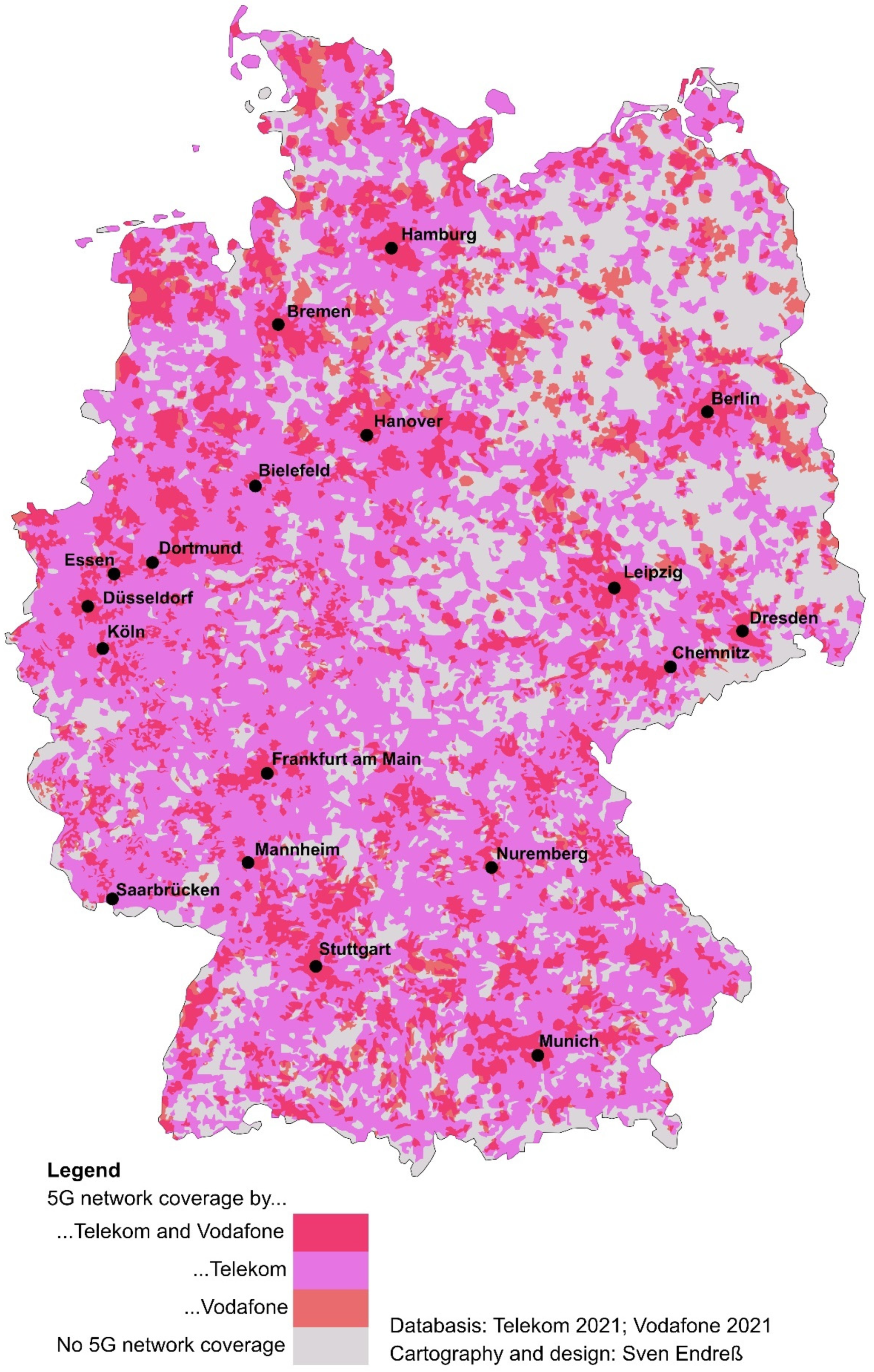

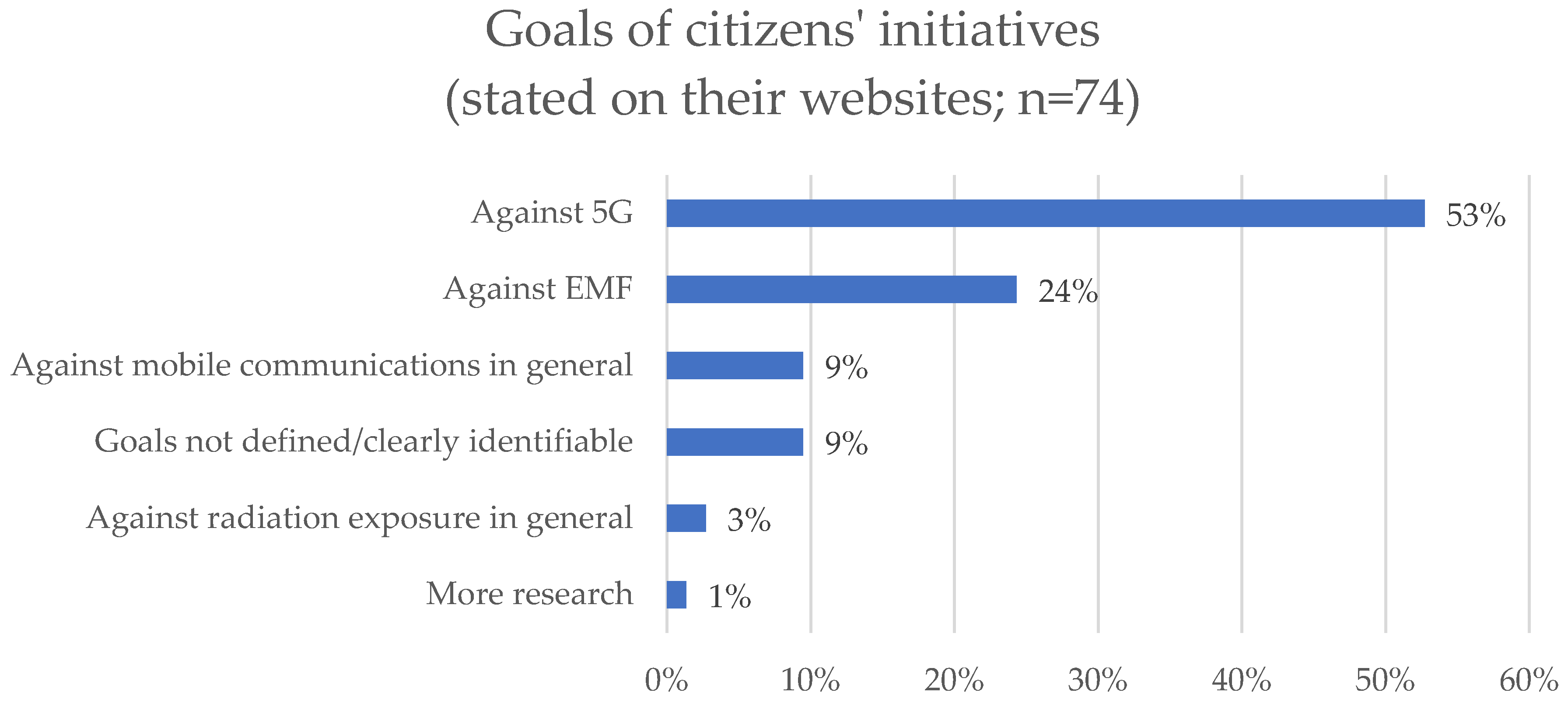
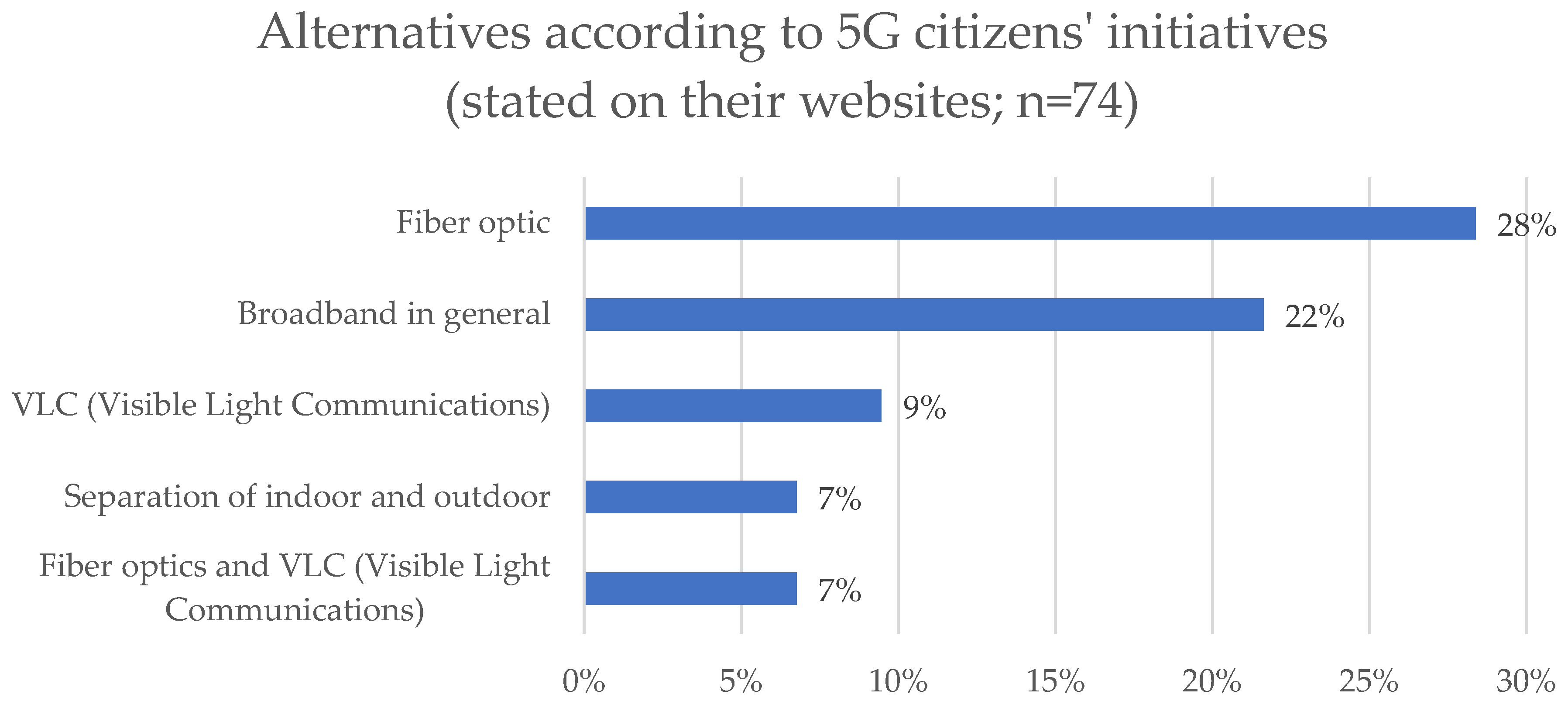
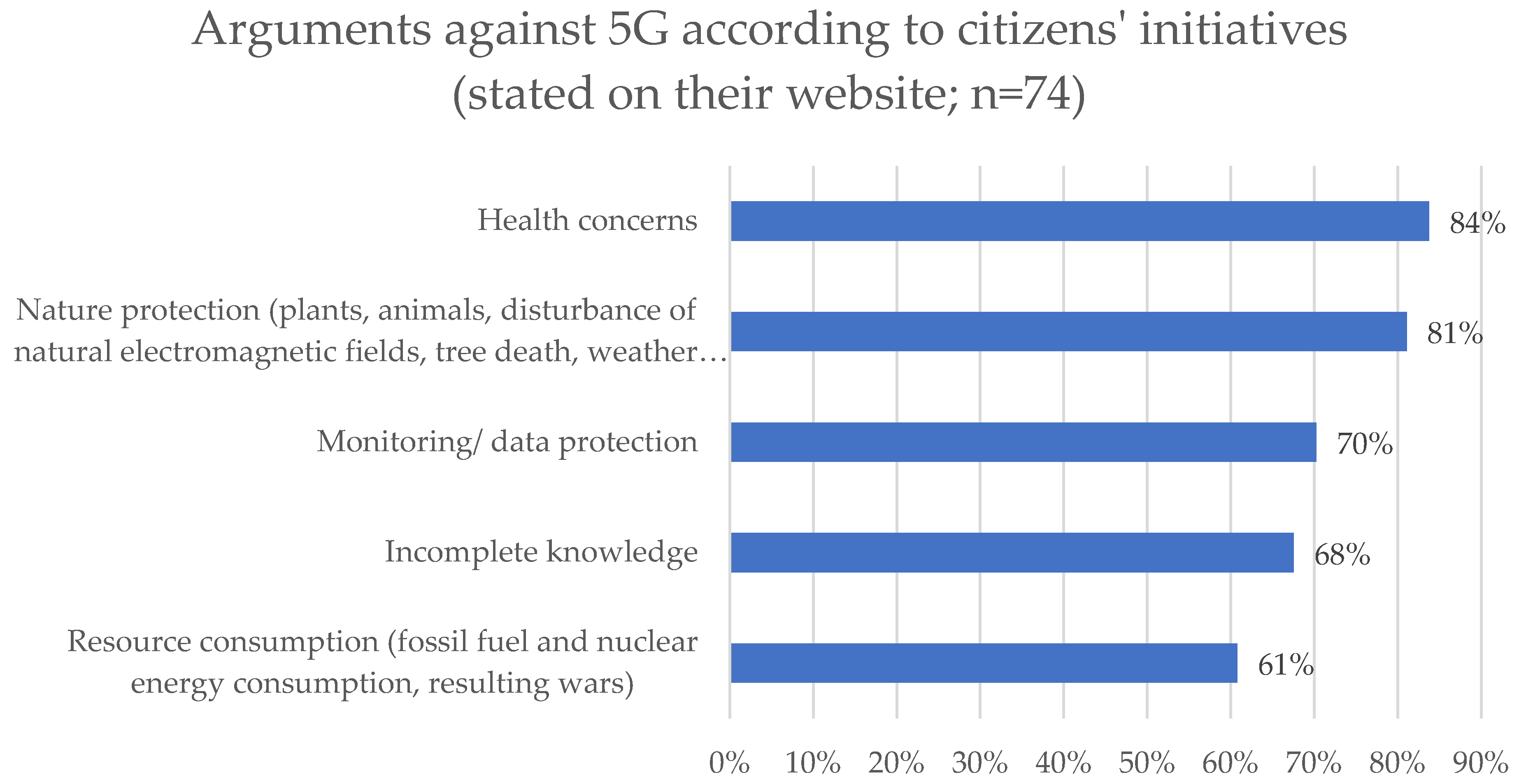
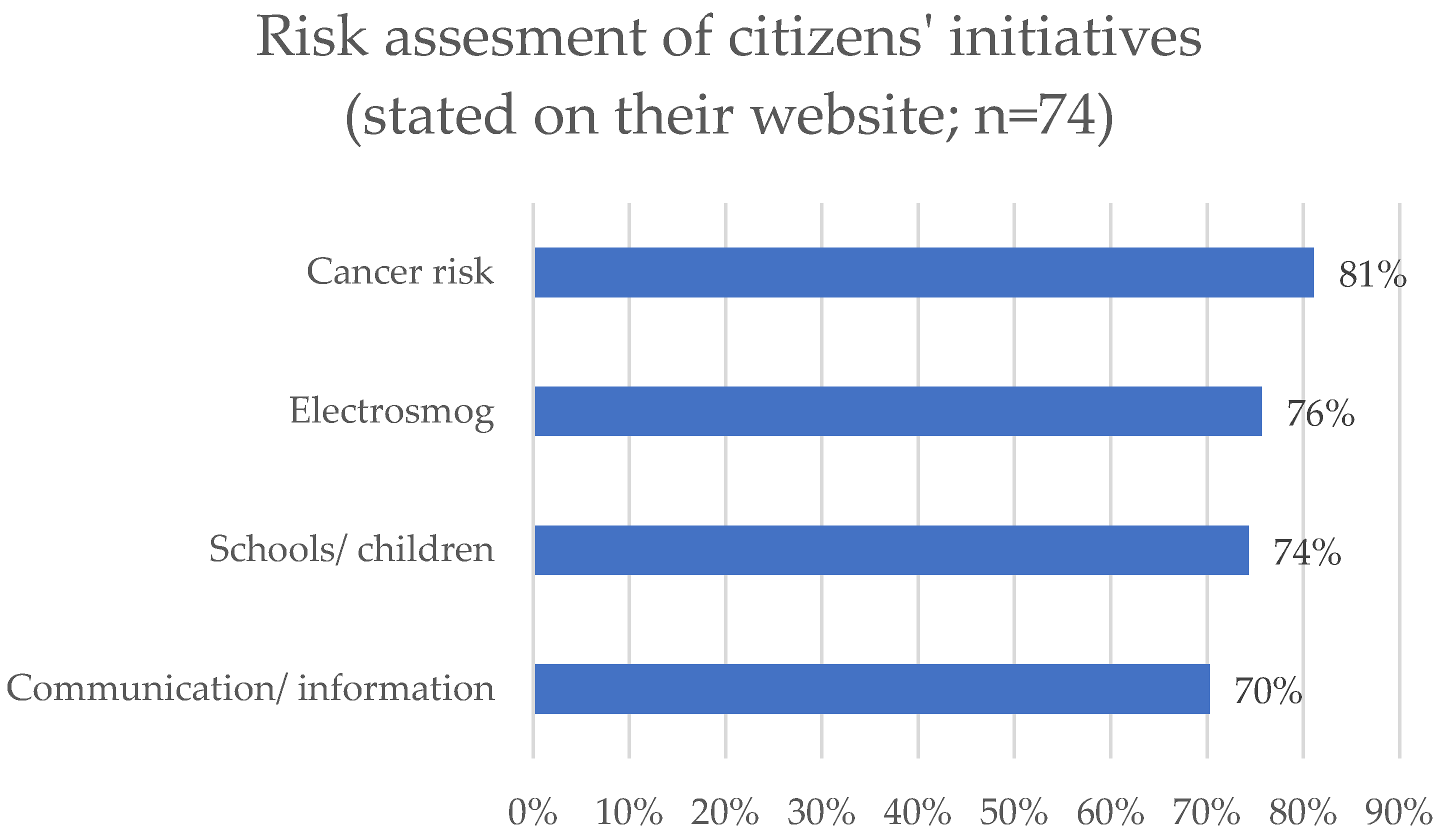
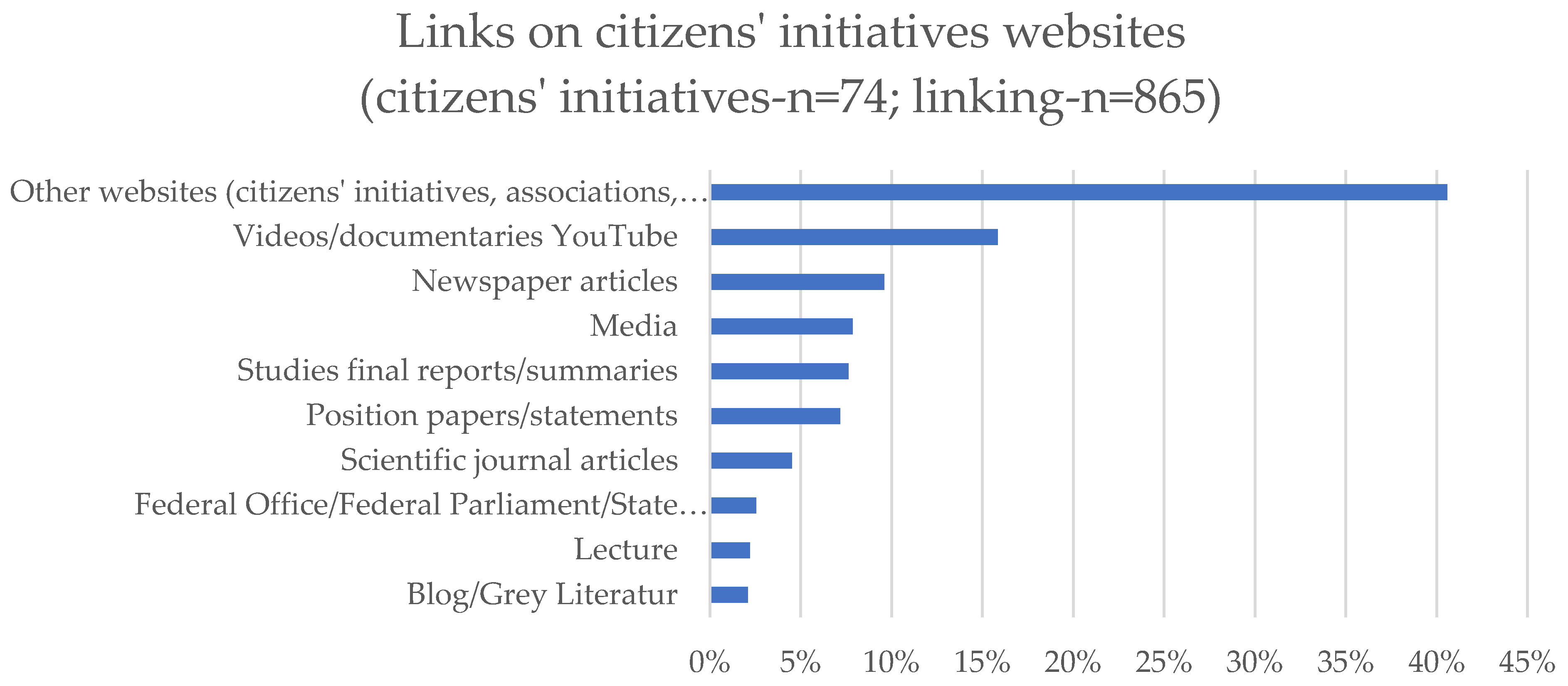

Publisher’s Note: MDPI stays neutral with regard to jurisdictional claims in published maps and institutional affiliations. |
© 2021 by the authors. Licensee MDPI, Basel, Switzerland. This article is an open access article distributed under the terms and conditions of the Creative Commons Attribution (CC BY) license (https://creativecommons.org/licenses/by/4.0/).
Share and Cite
Jenal, C.; Endreß, S.; Kühne, O.; Zylka, C. Technological Transformation Processes and Resistance—On the Conflict Potential of 5G Using the Example of 5G Network Expansion in Germany. Sustainability 2021, 13, 13550. https://doi.org/10.3390/su132413550
Jenal C, Endreß S, Kühne O, Zylka C. Technological Transformation Processes and Resistance—On the Conflict Potential of 5G Using the Example of 5G Network Expansion in Germany. Sustainability. 2021; 13(24):13550. https://doi.org/10.3390/su132413550
Chicago/Turabian StyleJenal, Corinna, Sven Endreß, Olaf Kühne, and Caroline Zylka. 2021. "Technological Transformation Processes and Resistance—On the Conflict Potential of 5G Using the Example of 5G Network Expansion in Germany" Sustainability 13, no. 24: 13550. https://doi.org/10.3390/su132413550
APA StyleJenal, C., Endreß, S., Kühne, O., & Zylka, C. (2021). Technological Transformation Processes and Resistance—On the Conflict Potential of 5G Using the Example of 5G Network Expansion in Germany. Sustainability, 13(24), 13550. https://doi.org/10.3390/su132413550






